Tender yet crispy pork slices flavoured with fermented seasonings, twice cooked pork is a mouth-watering Chinese delicacy. This recipe provides many tips on how to achieve the best flavour and texture.
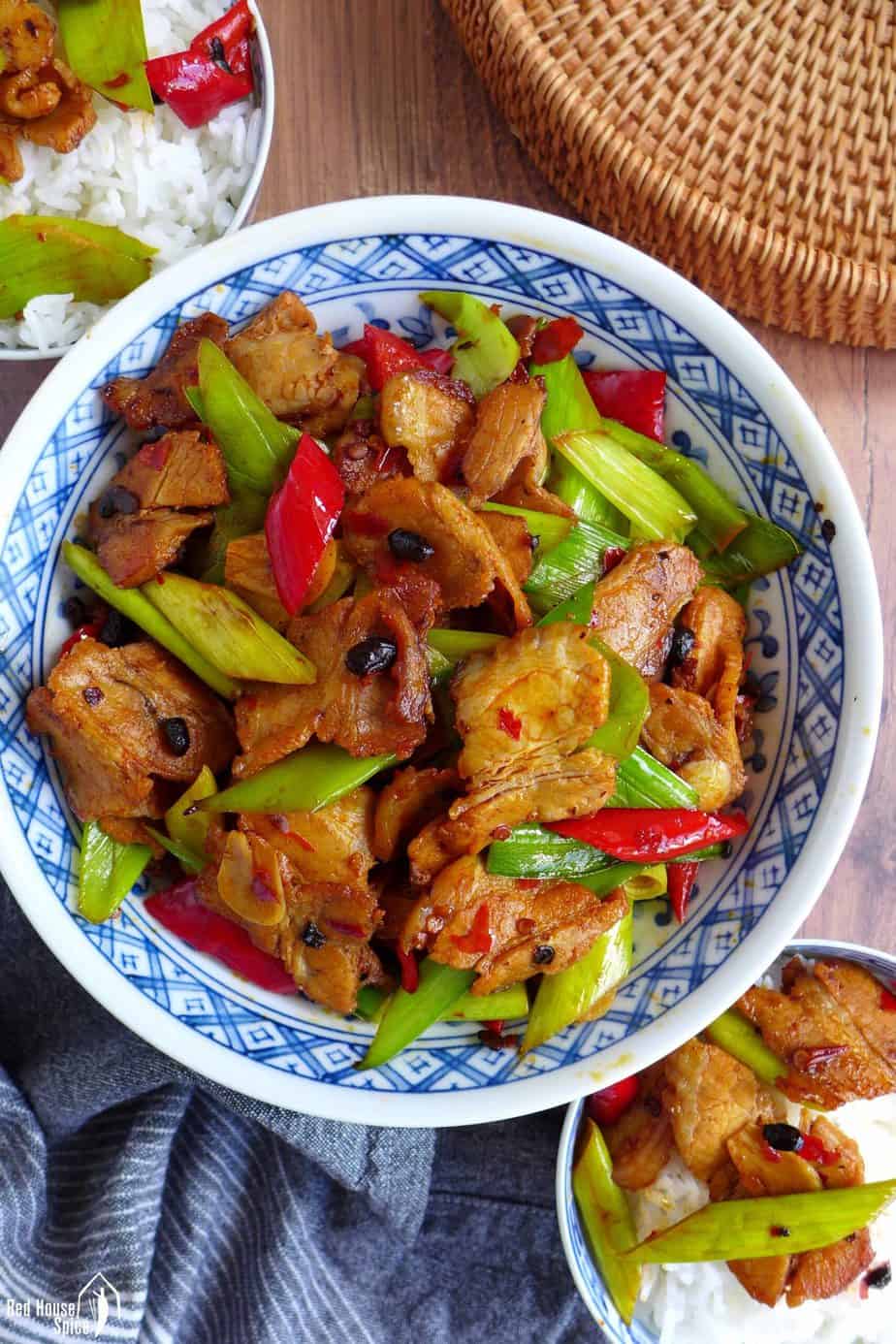
What is twice cooked pork
If you ask me to name the ten most popular dishes of Sichuan cuisine, twice-cooked pork will definitely make it onto the list (probably among the top 3). The Chinese name of this classic dish, Hui Guo Rou/回锅肉, literally means “the meat (it refers to pork belly) that returned to the wok”. It explains the special two-step cooking method which gives the dish a delicious, complex texture.
- Firstly, a chunky piece of pork belly is simmered in water then cut into thin slices.
- Secondly, the cooked pork returns to a wok to be stir-fried with vegetables and seasoned with condiments.
Twice-cooked pork shares a similar flavour profile as classic Sichuan dishes such as Mapo Tofu and Spicy Vermicelli Stir-fry. The key flavour, fragrant and spicy, comes from two versatile condiments: chilli bean paste and fermented black beans. Vegetables, such as leek, green garlic, fresh chili, etc. are added to provide the nutritive balance of the dish.
Four key ingredients to ensure authenticity
Before walking you through the cooking procedures, I’d like to talk about the four key ingredients that make this dish stand out.
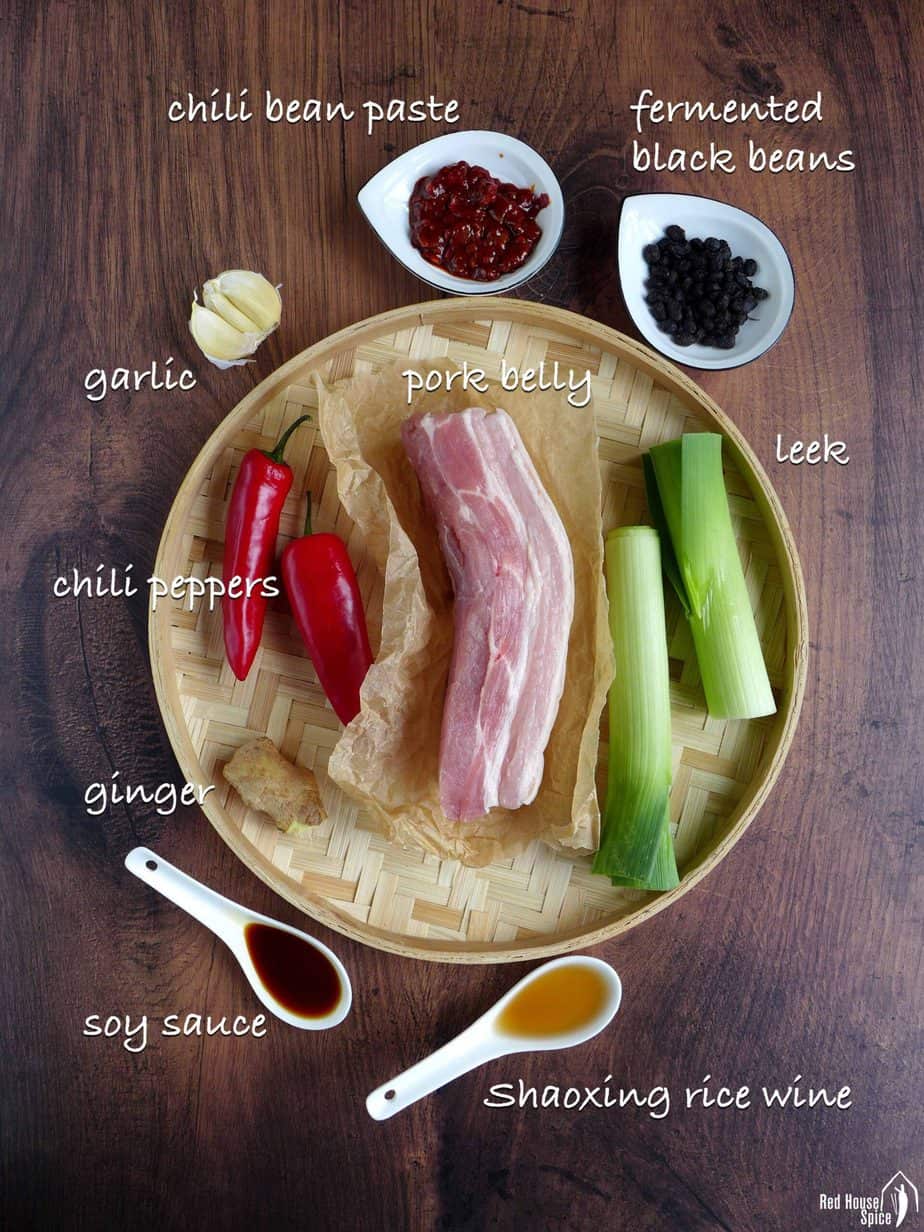
Pork belly
When developing recipes, I always keep in mind possible substitutes for certain ingredients. For example, I often list the best cut for a meat-based dish then give suggestions on how to adjust when using less favoured cuts. However, for twice cooked pork, I have to say that pork belly is indispensable.
Despite the high-fat content, pork belly dishes don’t taste particularly greasy when properly prepared. For this twice cooked pork, some fat is removed from the pork belly during the boiling process. Then for the stir-frying part, you only need a little cooking oil as more fat will be extracted from the pork over high heat.
Sichuan chili bean paste
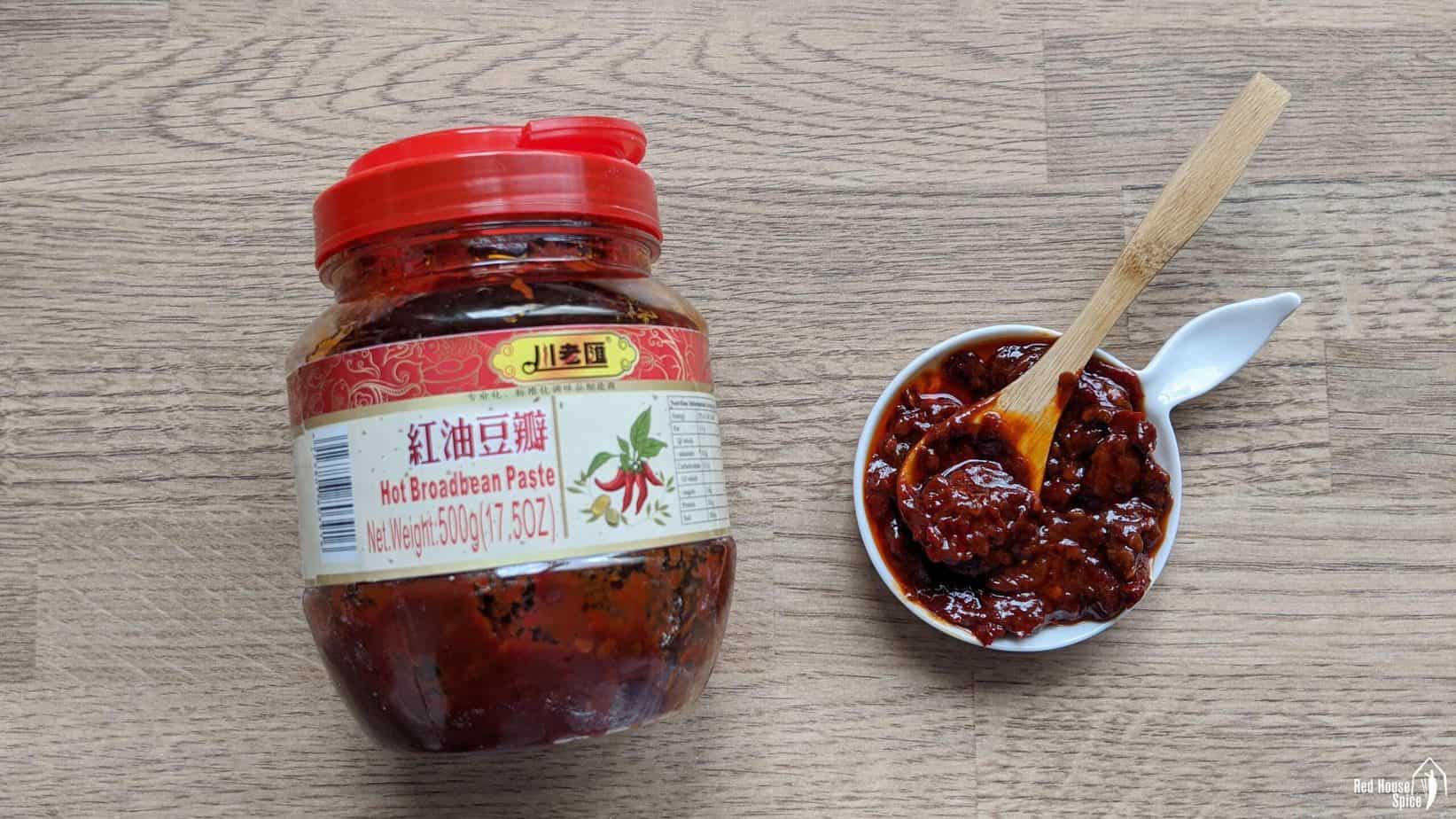
When it comes to Sichuan chilli bean paste, the iconic condiment of Sichuan cuisine, there is often confusion when purchasing due to the variety of names translated in English. Essentially, it’s a dark red sauce consisting of fermented broad beans and hot chilies. You can find the following names from different brands and packagings:
- Dou Ban Jiang (Doubanjiang) is the Pinyin form for its Chinese name 豆瓣酱.
- Broad bean Paste is sometimes used as broad beans are the main ingredient.
- Pixian Dou Ban (or Pixian Broad Bean Paste/郫县豆瓣) is the best-known variety which is produced in a town named Pixian.
- Hot Broad Bean Paste (红油豆瓣) refers to the Pixian Dou Ban with extra chilli oil. It’s a little spicier and has an appetizing red colour.
If possible, I suggest you use Hot Broad Bean Paste/红油豆瓣 (see image above) and avoid Lee Kum Kee Chili Bean Sauce which doesn’t reflect the true taste of Sichuan chilli bean paste. I’m often asked if there are any substitutes, unfortunately, the answer is No. I highly recommend you try sourcing it in Chinese stores or online shopping platforms. I’m sure you’ll be hooked by its wonderful taste and inspired to make more dishes with it.
Fermented black beans
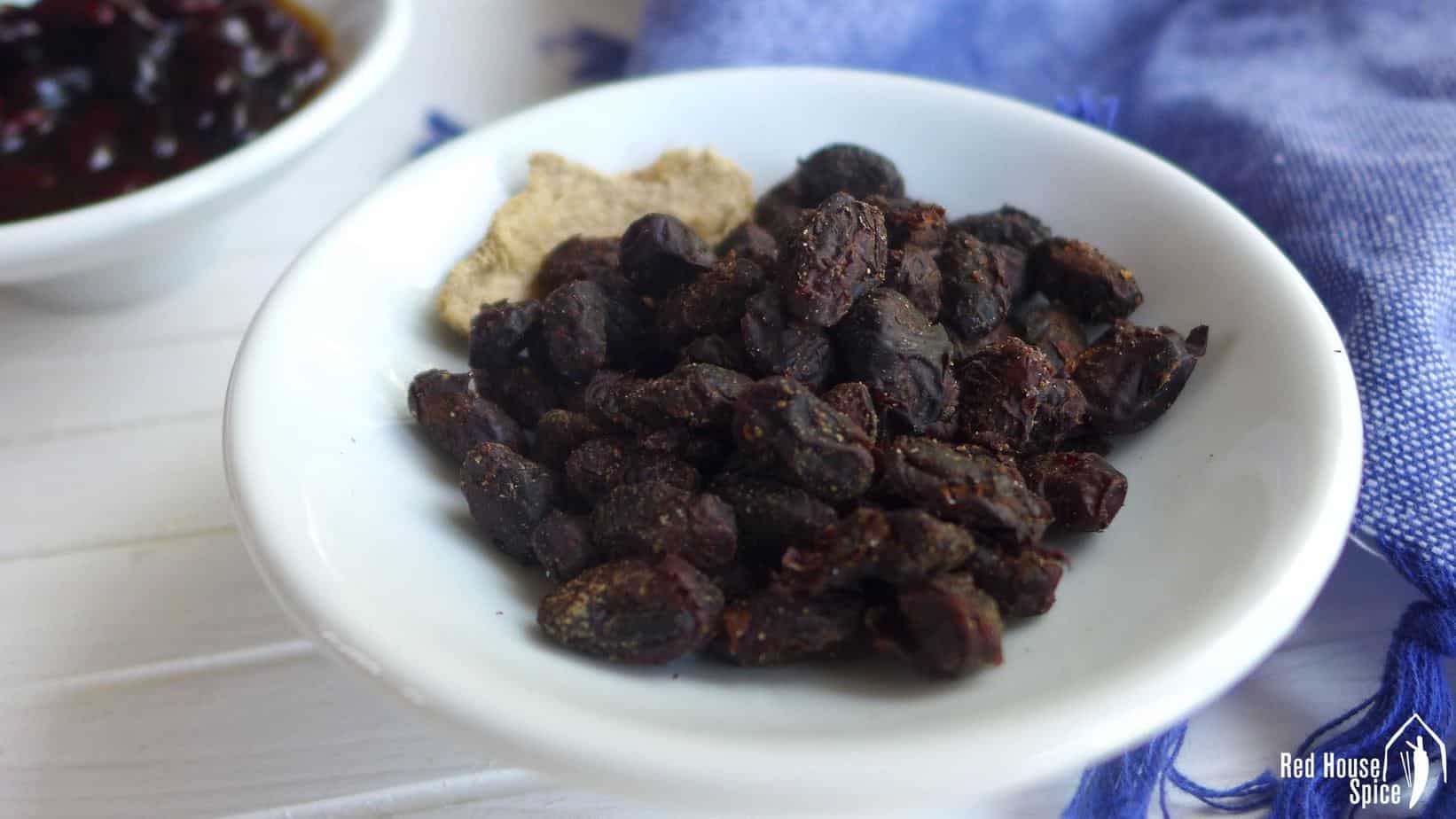
Often paired with Sichuan chili bean paste in Sichuan dishes, fermented black beans (Duo Chi/豆豉) are quite unique in terms of flavour: aromatic, umami, earthy, salty and a little bitter. They can be found in Chinese stores and major online shopping platforms. When purchasing, look for the dried type (see image above) instead of the salted ones in brine. I usually use a reputable variety called Yang Jiang preserved beans (阳江豆豉) in which you often find a few pieces of dried ginger.
Leek, green garlic or celery
Traditional twice cooked pork calls for green garlic (Suan Miao/蒜苗), a young garlic plant that resembles scallions, to go with the pork belly. It gives the dish a nice colour, an aromatic, garlicky taste, as well as making it healthier. Unfortunately, around where I live in England, I have no access to this tasty vegetable that I have adored since childhood. But the good news is I find leek to be a great substitute. I also like celery (cut diagonally into thin slices) in this dish.
How to pre-cook the pork
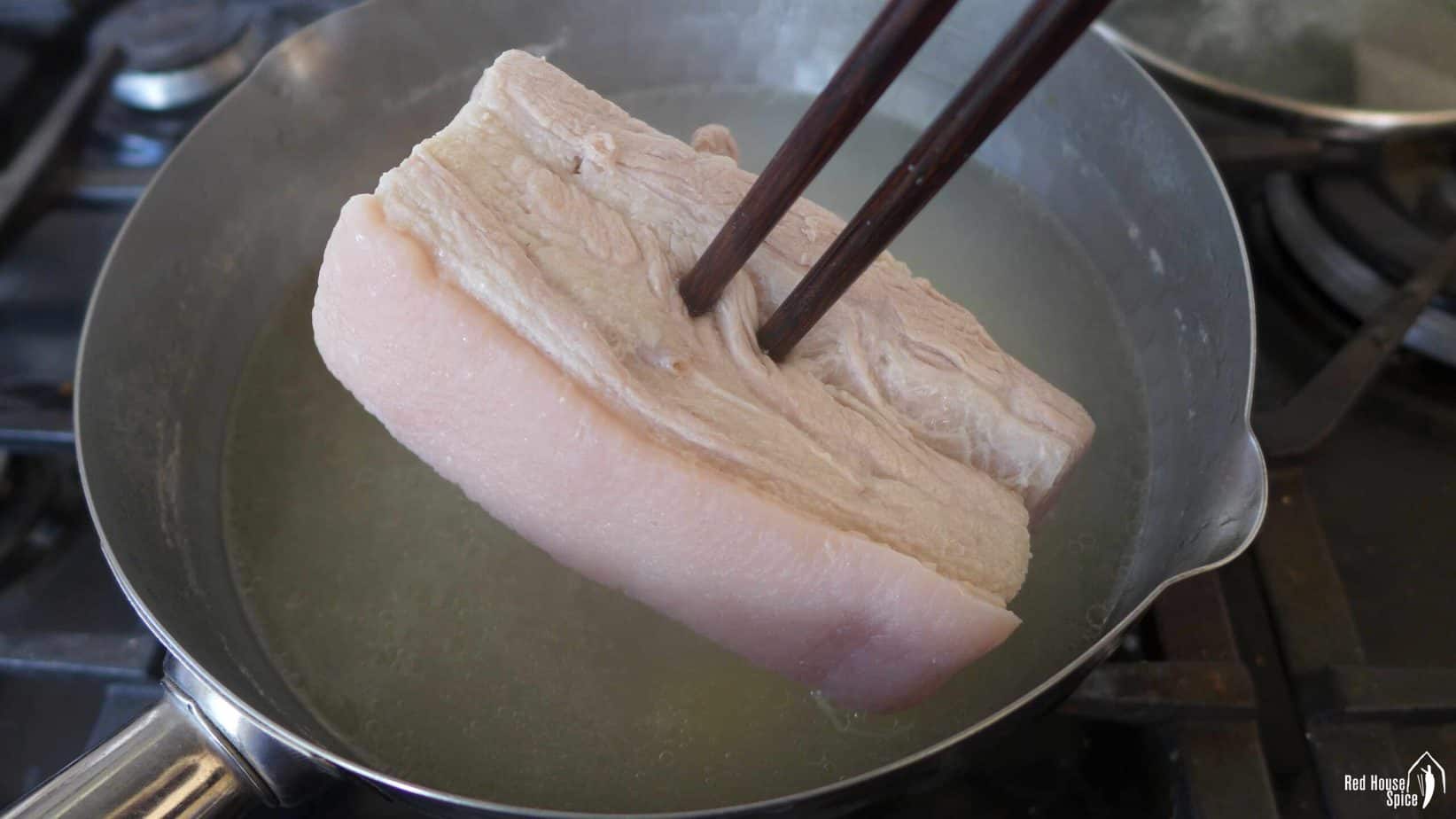
As I mentioned earlier, unlike other pork stir-fries (e.g. Sichuan Shredded Pork with Garlic Sauce), you need to pre-cook the pork belly before slicing and frying it in a wok. It’s a simple, straightforward procedure:
- Put a strip of thickly cut pork belly into a pot. Pour enough water to cover the meat. Add a few slices of fresh ginger.
- Bring the water to a full boil. Turn down the heat to low then leave to simmer for 30 mins (increase the time a little if you’re cooking a larger amount).
At this stage, the pork should be fully cooked but not to a tender, melt-in-your-mouth texture. Insert chopsticks to test. They should be able to go through the meat with a little resistance. Don’t overcook though. Otherwise, it will make the next step, slicing, more challenging.
Cut the pork into thin slices
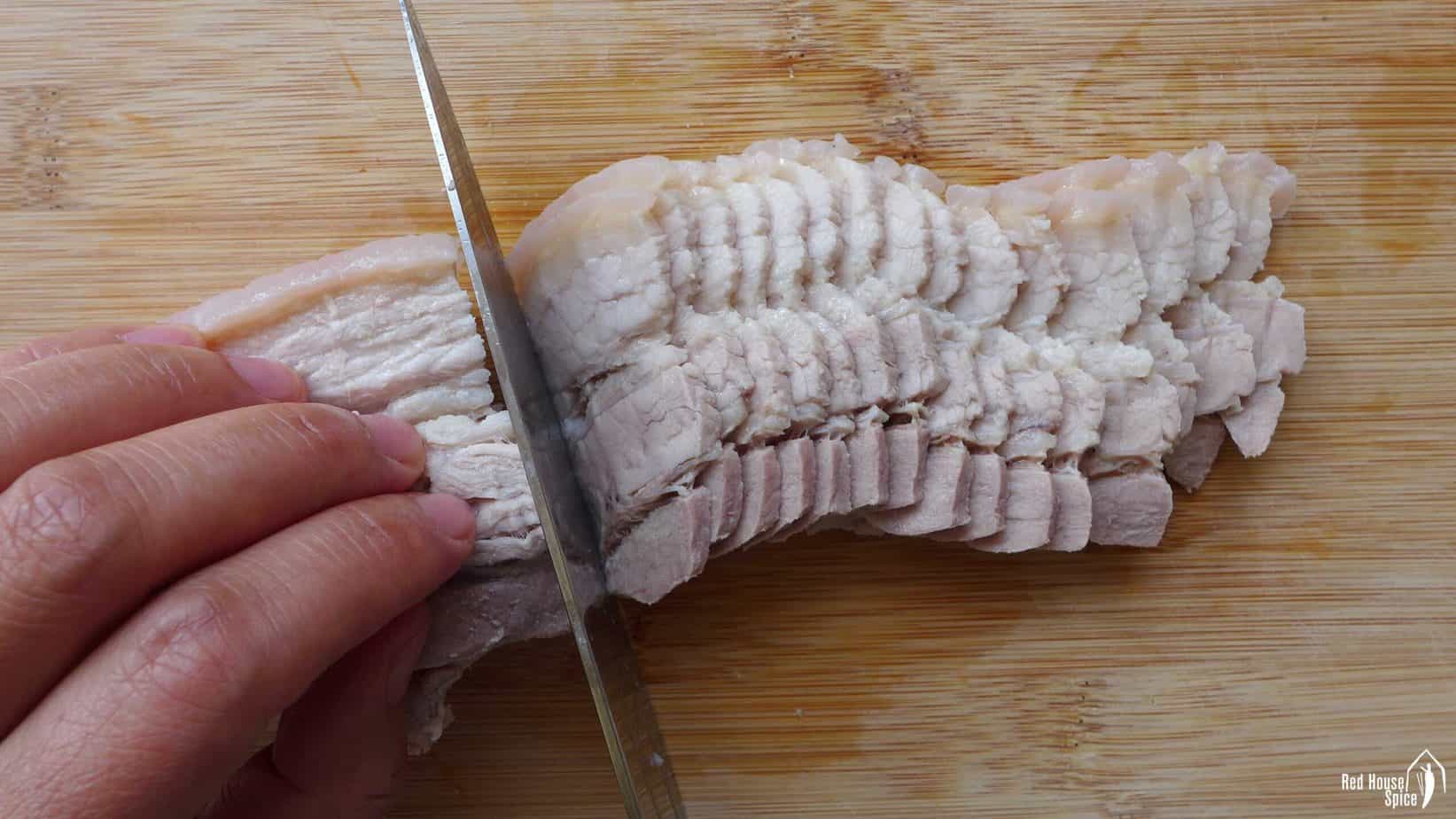
As soon as the pork is cooked, drop it into a bowl filled with water to cool. You can take this time to prepare other ingredients for the dish: chopping the leek, peel the garlic, get all the condiment ready, etc. When the pork is cool enough to touch, cut it crossways into thin slices (remember to sharpen your knife beforehand).
If your piece of pork belly is on the fatty side (about 1:1 fat lean ratio), try your best to cut it as thin as possible. This way, more fat can be rendered during frying and it will gain a crispier texture. On the other hand, if it has less fat, cut a little thicker to ensure that the final taste won’t be too dry. The piece shown in the image above isn’t too fatty so I cut it into slices about 4mm thick.
How to stir fry to perfection
Now let’s move on to the final step: stir-frying. Although quite simple and straightforward, I’d like to explain each step with a few tips to help you achieve a perfect end result.
Step 1. Caramelise the pork
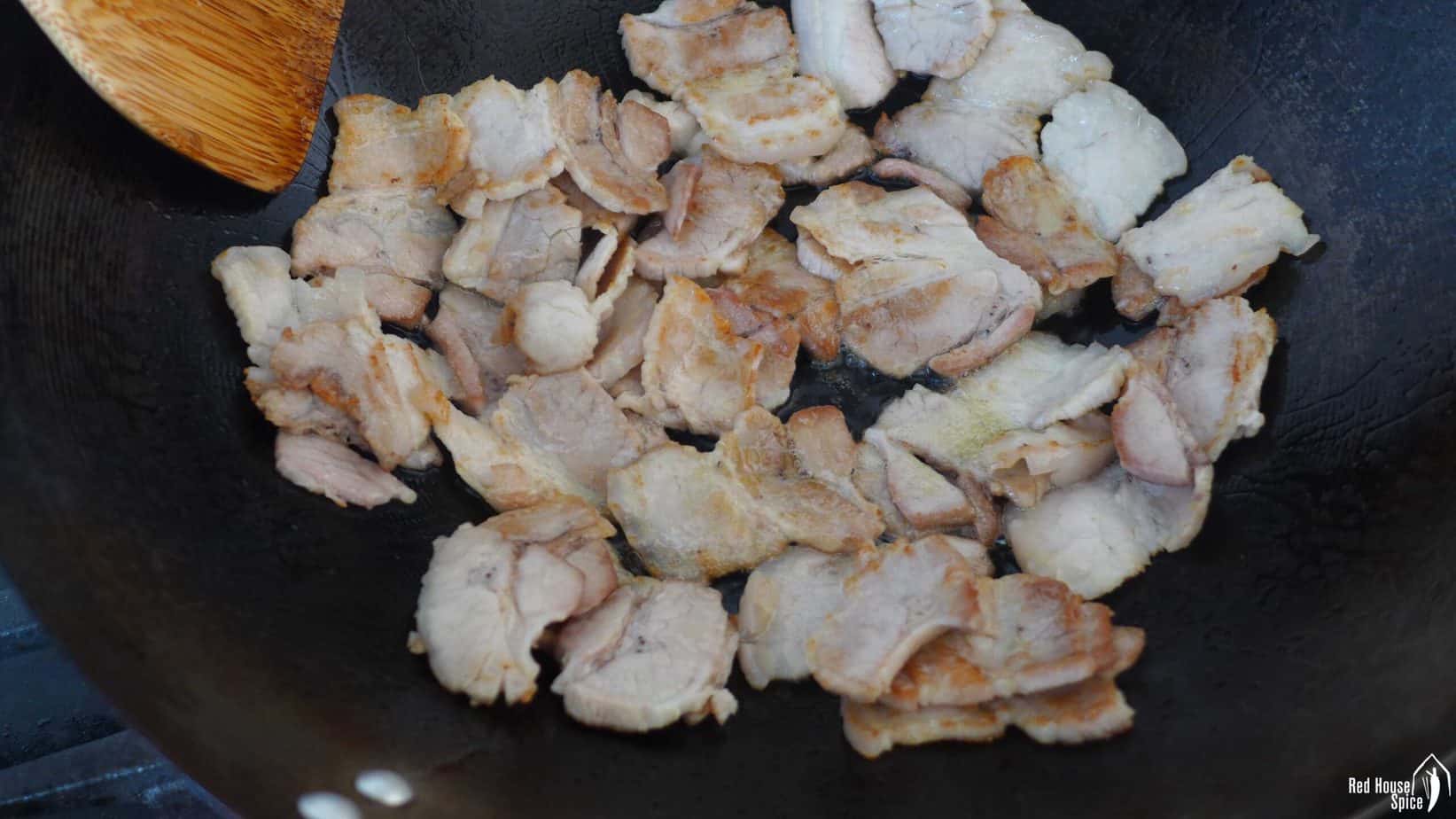
Set the wok over high heat until it starts to smoke. Pour in oil and add pork belly pieces. Stir constantly to sear the meat evenly. Once it lightly browns, transfer to a plate but leave all the oil in the wok.
Tip: I use a traditional carbon steel wok to cook this dish. A non-stick wok works fine too. However, please be aware that you’re not supposed to heat it when empty. Instead, pour the oil into your wok then turn on the heat. When the oil starts to smoke, add the pork.
Step 2: Sizzle the aromatics

Turn the heat to low. Add Sichuan chili bean paste, fermented black beans and garlic to the oil. Sizzle for 30 seconds or so.
Tips: It’s very important to fry these three ingredients over low heat. This way, you’ll bring out their best flavour without burning them.
Step 3: Add vegetable & seasonings
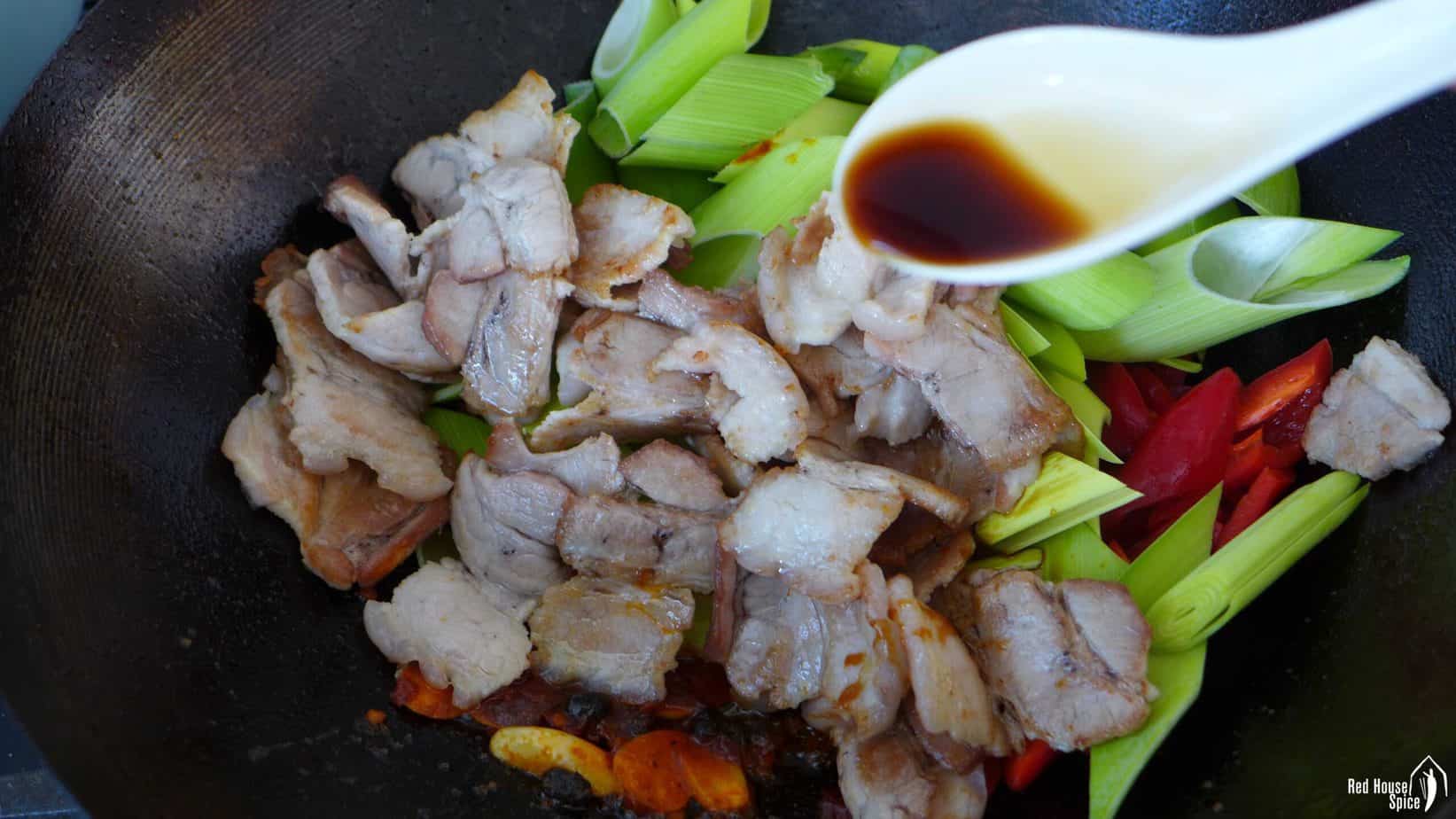
Turn up the heat to high. Put the pork slices back into the wok. Add leek, fresh chili, Shaoxing rice wine, soy sauce and sugar. Stir fry until the leek and chili start to wilt. Dish out and serve immediately.
Tip: Try not to overcook during this step. Otherwise, the pork might dry out. You should turn off the heat once everything is evenly coated with the sauce. The vegetables should still taste a little crunchy.
Creative ways to serve it
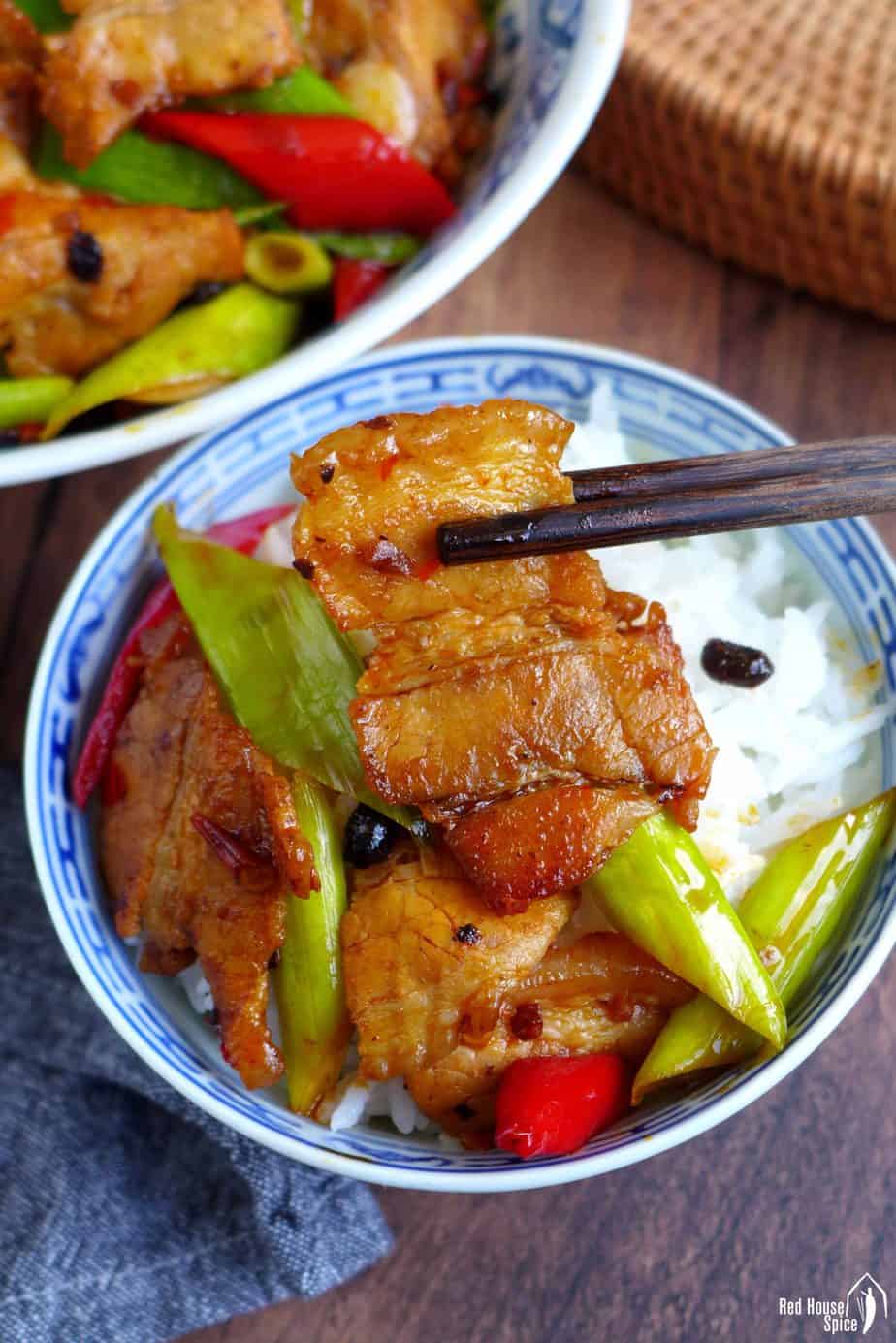
No doubt that twice cooked pork is a wonderful dish to “send your rice down” (Xia Fan/下饭, the Chinese expression to describe dishes that are so savoury and delicious that you tend to eat more rice than usual). However, there are many other ways to enjoy this delicacy. Here are some other ways that I enjoy:
- Use it as a topping for my Hand-pulled Noodles
- Wrap it in a Chinese Spring Pancake
- Replace the braised pork belly with it in Gua Bao (Taiwanese Pork Belly Buns) or Rou Jia Mo (Chinese Pork Burger)
Use the same formula to cook tofu
Love the sound of the taste but wish to make it vegetarian? It’s possible! I regularly make twice cooked tofu with the same set of flavourings. Firstly, fry pieces of tofu (coated with a thin layer of cornstarch) in a little oil until golden then transfer out (the same method is used for my recipe “Pan-fried Tofu with Garlic Sauce”). Secondly, follow the same procedure to stir fry with Sichuan chilli bean paste, fermented black beans, leek, etc.
Other yummy dishes using pork
If you have experienced authentic Chinese food, you probably have realised how much Chinese people adore pork (no matter from which regional cuisine). If you’re a fan too, check out these mouth-watering recipes:

Twice Cooked Pork (Hui Guo Rou, 回锅肉)
Ingredients
- 300 g pork belly, in one piece - 10oz
- 5 slices ginger
- 2 teaspoon cooking oil
- 1 tablespoon Sichuan chilli bean paste - see note 1
- 1 tablespoon fermented black beans (Dou Chi, 豆豉) - see note 2
- 3 cloves garlic, sliced
- 1 small leek, cut diagonally - see note 3
- 2 fresh red chili peppers, cut diagonally
- 1 teaspoon light soy sauce
- 1 teaspoon Shaoxing rice wine
- 1 pinch sugar
Instructions
Precook the pork
- Place pork belly and ginger into a pan. Pour in enough water to cover the meat. Bring the water to a full boil. Turn down the heat and leave to simmer for 30 mins (see note 4).
- Drain the pork then put it into a bowl of cold water. Once it’s cool enough to touch, cut it crosswise into thin slices.
Stir-fry the dish
- Heat the wok over high heat until it starts to smoke (See note 5 if you’re using a non-stick wok). Pour in oil and add pork belly pieces.
- Stir constantly to sear the meat. Once it lightly browns, transfer to a plate but leave all the oil in the wok.
- Turn the heat to low. Add Sichuan chili bean paste, fermented black beans and garlic to the oil. Sizzle for 30 seconds or so.
- Turn up the heat to high. Put the pork slices back into the wok. Add leek, fresh chili, Shaoxing rice wine, soy sauce and sugar. Stir fry until the leek and chili start to wilt (but still a little crunchy). Dish out and serve immediately.
NOTES
NUTRITION DISCLOSURE: Nutritional information on this website is provided as a courtesy to readers. It should be considered estimates. Please use your own brand nutritional values or your preferred nutrition calculator to double check against our estimates.
N.B. This post was first published in June 2017 and revised in Sept 2020.







My wife is from Leshan Sichuan and cooks this regularly. I LOVE IT, it’s so tasty. I will surprise my wife by cooking it for her using this menu. Thanks!
I hope you’ll nail it Scott!
Great recipe–the recommendation on the broad bean with chili oil made all the difference. Growing up in NY I remember the dish with cabbage and bell pepper along with the leek in the Szechuan restaurants there–I added that and it tasted just like I remembered it!!!!!
I had never cooked with pork belly so it was a positive new experience and will definitely try the authentic version you have in your recipe by leaving out the cabbage and bell pepper.
The spicy level was perfect for me. Thank you for such a great recipe!! Your recipes are so good!
Very classy delicious recipe. My family loved it.